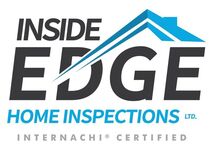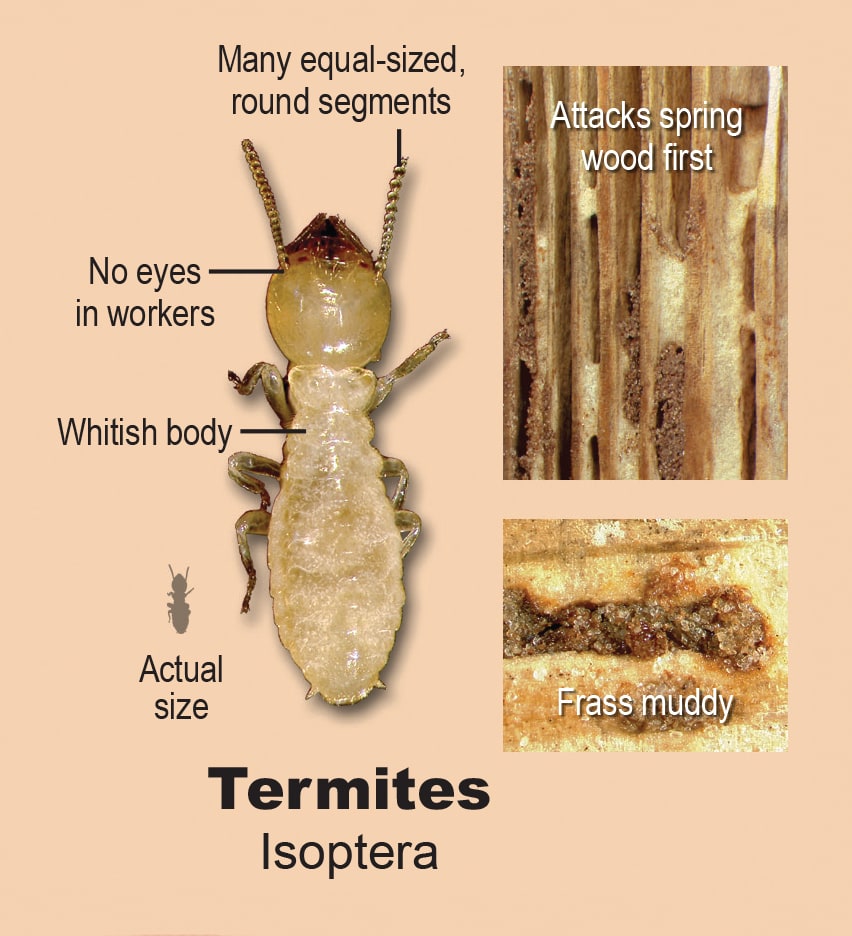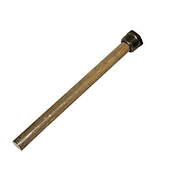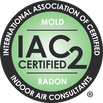Mike's Home Inspector BlogMichael Burfitt |
|
Termites are by far the most destructive wood destroying organism (WDO) in North America. It is estimated that they cause $5 billion+ in damage annually compared to $200-300 million by the second worst WDO offender (carpenter ants). The average cost to remove Termites can top $3500 and that does not guarantee they will never come back or include the cost of major structural repairs. How much of a danger are termites to homes in Nova Scotia?
First, the good news: as of the date of this post (September 2021) while termites have been detected in areas with a similar climate such as Maine and Southern Ontario, we do not have verifiable evidence of termite infestations in Nova Scotia and they current do not pose a threat whatsoever. However, there is more to the story than saying there is no danger of termites. In reality, not only do we have other (less destructive) WDOs such as carpenter ants, carpenter bees and longhorn beetles, but with climate change there is a strong possibility that termites can potentially take root in our province in the near future, especially if they are accidently introduced such as what likely happened in Toronto in the 1930s. While all WDOs are destructive, the termite is by far the biggest danger to homes. This is because unlike carpenter ants for example who only chew wood (usually moist) to clear room for nests, termites eat wood and will target even healthy, dry wood. Even worse, termites can be extremely difficult to detect and can cause untold destruction before leaving any evidence of their existence. Making it worse, they can be almost impossible to detect during a standard home inspection and even trained pest control experts can miss termite infestations. As much as I hope termites never make it to our province, they are being spotted in more and more northern areas of North America all the time and it is foolish to think we are immune. Here are some quick signs of termite infestations:
The biggest difference between carpenter ant and termite damage is twofold: not only are carpenter ants not as destructive but are generally much cleaner and leave more evidence. After all, much like us humans they are usually looking to build a nice home and not to literally eat us out of house and home like termites! As well, thanks to our cold winters, even the worst hit areas of Canada are nowhere near as bad as the southeastern United States. Even being in a very low risk area I would not be completely shocked if in the next few years termites are discovered in the Maritime Provinces as they are rapidly heading in our direction. I am a home inspector that regularly compares notes with other inspectors and inspection companies throughout Canada and the United States. To say that termites can cause problems to homeowners is the ultimate understatement. Let's hope that if you are reading this in the future we still do not have any termites in our province. I mention how much I love being a home inspector to the point you may wonder is there anything I don’t like about inspections. Yes, like any job it’s not always sunshine and roses, and at the top of that list is being in a homeowner’s personal space. I am aware that a house is not just a collection of drywall, wood, asphalt, and vinyl but a sanctuary from the rat race, a safe place to relax after a hard day and a place to make cherished family memories. I have developed an ability to look past personal belongings to the point you could leave a sack of money on the kitchen table and I would probably not even see it. Unfortunately, not everyone has that ability, and some will actively try to illegally enter a home to remove said sack, commonly known as a burglar. Residential break-ins can happen anywhere and contrary to the stereotype of the masked man hiding in the shadows like a raccoon, many burglars can dress and act like someone who makes regular house visits, such as a delivery driver or an appliance technician. As well, most burglaries happen during the workday and almost never when the home is occupied. Here are a few quick facts:
Check Hinges on Outward Swinging Doors Most burglars are not going to forcefully break down a door or window as it attracts a lot of negative attention and will almost certainly get a call to the police from a neighbour. Criminals are looking for easy and quiet ways of entry and there is no easier way (other than unlocked doors) than with doors that swing outward. While they are usually in garages, I have seen them used on plenty of back doors and without modifications, they can be popped off within seconds even with a powerful deadbolt. Investigate to make sure a modification has been made (such as adding a screw) to make it much more difficult to remove if you have exterior doors that swing outside. Cut Back Shrubbery Not only is that a great idea from a moisture and pest point of view, but it is also a great way to cut back on potential hiding spots for burglars to access basement or ground level windows without being noticed. Be Alert Remember there is no stereotypical burglar look: in many cases they will disguise themselves as a new neighbour or a service person to not draw suspicion or attention. Like most honest service providers, I am highly identifiable as a home inspector representing Inside Edge with a uniform or company T-shirt, carry an InterNACHI ID card and drive a branded vehicle. I also protect my client's privacy and with only extremely rare life safety or legal exceptions do not discuss ANY of my findings with anyone. While I hope you never have to deal with a theft from your home, it is always a good idea to make an inventory of your valuables. I include an Appliance Audit in spreadsheet format with every inspection and will be happy to provide you with a blank template for your personal use free of charge: just send us an email (info@ieinspections.ca) and I will be more than happy to pass it along. To quote what was said to me many years ago: "there is no need to live in fear but there are plenty of reasons to live with caution". As both an entrepreneur and a holder of a bachelor’s degree in Commerce, I like to view hiring an independent home inspector as a financial investment with a great return: our (low) upfront fees will usually save you significant amounts of money on home maintenance down the road. I know in my own home I have saved thousands in maintenance costs over the years with my understanding of complex building systems. Today I want to show you how, for about $40 and a decent breaker bar or torque wrench (or better yet a plumber!), you can significantly increase the life of your water heater, even more so if you live outside of an area supplied by Halifax Water that has hard water. This is an anode rod, sometimes known as a sacrificial anode and is the key to extending the life of your tank. As the name implies, it sacrifices itself to take most of the corrosion away from the tank liner. Without getting into the boring science of electron flow, both magnesium and aluminum lose electrons (i.e., corrode, rust) much faster than ferrous metals such as steel, which is what most tanks are constructed of. These should be checked every year after 3 years and replaced as needed. At approximately $40, it is a lot cheaper and easier to replace than a tank: replacing ours on short notice cost us a total of $1300 just 3 days after moving into our home, not including spending our very first weekend cleaning up the mess and dealing with no hot water for the entire day.
Another way to keep your tank running well into the future is to flush it once a year: simply hook up a garden hose and turn the tap after shutting off both the power and water supply to clear impurities that have settled and cause significant rust. As I have mentioned before, a burst water tank is a deeply unpleasant experience that can be minimized with regular maintenance. Be sure to read the manuals for all your home’s equipment and appliances: there are valuable tips that can both extend the life of and improve efficiency of your home’s components. A home inspector will also look for other important safety features, such as a temperature/pressure relief valve and tube. While catastrophic tank failures are obviously rare, water heaters have an incredible amount of stored energy, and a failed tank can be shot up through the roof and into a neighbour’s yard like a rocket. Regular home maintenance can help insure you will never meet them in this way! Like most Canadian home inspectors, I have been asked on occasion what I think of Mike Holmes. Overall I have a positive opinion of him and have learned plenty watching his many shows over the years. My biggest criticism, however, is that he tends to exaggerate relatively minor issues and unintentionally misrepresent how easy it is to renovate a home, which given the limitations of television is understandable.
Before I became a professional home inspector, I imagined it was a lot like a TV show, where I look at an issue and loudly proclaim: “this is X, will cost Y and will take Z to complete!” The truth is that while some issues are black and white (i.e. missing safety devices) many defects I come across require me to draw upon my vast knowledge of building systems to evaluate. Here are just a few examples of symptoms that can be anything from cosmetic to catastrophic. Foundation Cracks One of the most concerning things a homeowner can face is a home that is sinking on one side. This can be a very expensive repair and in extreme situations it may even be cheaper to rebuild the entire house! While that sounds terrifying in reality this is a rare situation: nearly every home has foundation cracks and they are generally not a big deal. There are a number of variables I look at:
Sewage Smell Methane gas is not only unhealthy and explosive in large concentrations but smells terrible and can be very concerning. If a home smells of sewage, this could mean a sewer line clog or even worse, a break. Both are expensive to remedy and are very disruptive to a home’s occupants. Before waving the white flag and calling for a plumber, an inspector knows to check a few things first, particularly the home’s toilets. These are the only fixtures where the waste pipes do not have a trap to prevent sewer gas from escaping (they are in the toilet itself) and over time the wax seal keeping it in place to the floor will crack and loosen, leading to the unpleasant smell. This is a relatively minor repair and can be completed by the homeowner or a handyman. Potential Asbestos I recently had a real estate agent ask me how much of a concern Asbestos is for home buyers. The short answer is that it depends on where in the home it is located. If you follow this blog, you already know that Asbestos is very dangerous to long term health but only when in a friable (easily crumbled) state, where loose fibres can coat the lungs over time. If a house has asbestos (and a significant number of homes, particularly on the Halifax Peninsula or Downtown Dartmouth likely do), my advice will vary based on where the potential asbestos is located. If it is discovered in flooring tiles or siding the best option would be to leave it alone but it is in insulation, I generally suggest either covering or preferably having a qualified abatement contractor remove it. Ideally, I would love to wave a magic wand and remove all asbestos from homes but in reality, it is very expensive and time consuming to completely remove asbestos safely from a structure. Just like a doctor will usually suggest not searching the internet for symptoms, as a homeowner you should be cautious when looking at information online. There is a lot of scary information about topics such as Polybutylene Pipes, Flammable Insulation and Dangerous Decks but reality is far more subjective than the blanket statements I often see. These symptoms can suggest a wide variety of conditions but in my experience, they are usually on the mild end of the spectrum. |
Archives
April 2024
Categories
All
|



 RSS Feed
RSS Feed

